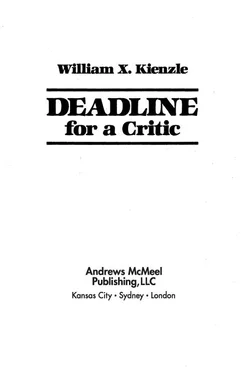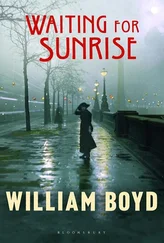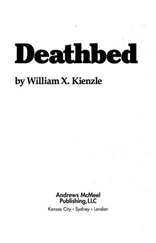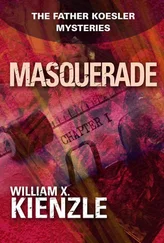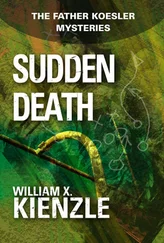She was confused, ashamed, embarrassed, and abandoned. She needed to talk but had no one to talk to. She could not tell her parents. She had no friend in whom she could confide such a secret.
She would tell a priest, of course, but that would be in confession. And he would not console her. He would excoriate her.
That night, Jane didn’t sleep. She wept. And when, in the early hours of the morning, her parents returned from their more innocent New Year’s Eve party, Jane turned her head to the pillow to muffle her sobs.
11
Father Koesler stepped to the lectern and read the Gospel story of Jesus calling Lazarus back from the dead. When he finished, all the priests present sat down. Following their example, the rest of the congregation sat.
At most weddings and funerals it was a safe bet to expect a goodly number of non-Catholics, lapsed Catholics, and infrequent Catholics, many of whom would be unfamiliar with the ritual of the Mass. Under these circumstances, it was common for a priest to tell the congregation to stand, be seated, or to kneel (or, if kneeling were perceived as a form of martyrdom, they might sit). But everyone, Catholic or not, would feel comfortable following the example of a bunch of priests. At least in the matter of protocol at Mass.
There were funerals and there were funerals. In his more than thirty years as a priest, Koesler had officiated at just about every possible variety. Basically, they fell into one of two categories. There were funerals in which there was great and sincere grief. Or funerals in which there was little if any genuine mourning.
On grief-filled occasions, it is difficult to find words of real consolation, so great is the sense of loss. When there is little mourning, it is difficult to find words that can stir feelings unaffected by the presence of death.
Except for the desolate presence of Peter Harison, Ridley C. Groendal’s funeral held no sense of mourning, loss or grief. Indeed, some in the congregation seemed to evidence relief, perhaps even elation. It was to this generally uncaring attitude that Koesler addressed himself in his approach to a homily.
Eulogizing Ridley Groendal would have been simple for Koesler. Seldom had the priest known a deceased more personally than he had known Ridley. In the end, it was the extent of Koesler’s knowledge of Groendal that argued against a eulogy. Koesler simply knew Ridley too well. If the priest had begun a biographical sketch, it would have been all but impossible to delete inappropriate facts and details. All things considered, it was wiser to go with one of the many standard homilies he had developed over the years.
So he began with a quotation from Benjamin Franklin written just a few weeks before the great statesman’s death:
“As to Jesus of Nazareth, my opinion of whom you particularly desire, I think the system of morals and religion, as he left them to us, the best the world ever saw or is likely to see; but I apprehend it has received various corrupting changes, and I have, with most of the present dissenters in England, some doubts as to his divinity, though it is a question I do not dogmatize upon, having never studied it, and think it needless to busy myself with it now, when I expect soon an opportunity of knowing the truth with less trouble. . . .”
The point of the quotation, as Koesler explained, is that it is impossible to prove empirically what happens after death. All we know, with certainty, is that we must die. After that, what? We move into the realm of heaven, hell, or purgatory. Or we are nothing. Or we return to earth in some other form. Benjamin Franklin refused to speculate on the final outcome, anticipating that—as it turned out—in a few weeks he would die. At which time, he would know the truth.
The Christian, Koesler continued, chooses to believe. In what? He returned to the first reading wherein King David expresses his willingness to die in the place of his son Absalom. Even though Absalom proved himself the most ingrate of sons, seeking his father’s overthrow and death, still his father loves him so much that even in the face of this hostility, David would die in Absalom’s place. It was easy to move from the figures of David and Absalom to God the Father and us His children.
Koesler then went on to the second reading where Paul points out that it is only barely possible to imagine laying down one’s life for a very good person, very dear to us: a husband, a wife, a parent, a child. How then can we comprehend the love of God who sends His Son to die for us while we are no better than sinners?
At that point, Koesler usually adapted a lesson once developed by John Henry Cardinal Newman on the tears of Christ at the graveside of Lazarus. The Gospel story records Jesus weeping as he stood outside the tomb. The bystanders were moved to comment, “See how much he loved Lazarus!”
The strange feature of the story is that Jesus must have known that within minutes this scene of mourning would be transformed into one of incredible and incredulous happiness. Because Jesus would command that the large stone blocking the tomb’s entrance be rolled back. Then he called to the dead man, “Lazarus, come forth!” And the corpse, entombed three days before, lived again.
The point that Newman made, and Koesler borrowed, was that Jesus must have been moved to tears simply because his friends themselves were inconsolably grief-stricken.
In all, it was a homily emphasizing the love and forgiving power of God.
As he delivered the homily, Koesler made eye-contact with various members of the congregation. Judging from their expressions, Ridley was in desperate need of a good measure of love and forgiveness from someone. And no one is in a better position to give it than God. Perhaps the only one.
As he surveyed the congregation, Koesler intermittently fixed on the five people whose lives had so mingled with Ridley’s and, to some extent, with Koesler’s.
Peter Harison, David Palmer, Carroll Mitchell, Valerie Walsh, Charles Hogan.
Each had touched—some would say collided with—and changed the others’ lives. Their influence continued even unto death.
Valerie Walsh was a beautiful woman. Her garb, considering that she was attending a funeral, was rather defiant: red overcoat and green fur hat. She appeared more to be celebrating the Christmas season than mourning a deceased person. Well, truth in advertising: More than likely, she was celebrating.
It was remarkable how very much Valerie resembled her mother. Yet Jane Condon was pretty rather than beautiful. Whereas Valerie knew far better how to help her natural good looks with just the right makeup and hairstyling.
In fact, if it had not been for what had happened between Groendal and Condon, Koesler would have been hard-pressed to remember what Jane Cordon looked like. Koesler had probably seen her many times in her role as an usherette at the Stratford. He undoubtedly had seen her often as a student at Holy Redeemer. But he’d never really noticed her. He had never paid any attention to her until those few sparks had flown between Jane and Ridley during that Christmas vacation so long ago.
What a profound change that had brought to their lives! Strange how little the time they had had together and yet what an impact those few hours had had on them.
Ridley had told Koesler about it, but not until they had returned to the seminary after Christmas vacation. He told all just as it had happened, sparing almost no detail. Koesler, uncomfortable throughout, had tried to interrupt and bail out several times. But Ridley had insisted that he be heard out. Finally, he got to the part where, after struggling into his overcoat, he had gone home to spend a sleepless remainder of the night.
“And that’s it?” Koesler asked.
Читать дальше
